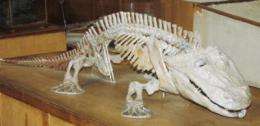Did bone ease acid for early land crawlers?

Here's an anatomical packing list for making that historic trip from water to land circa 370 million years ago: Lungs? Check. Legs? Check. Patches of highly vascular bone in the skin? In a new paper, scientists propose why many of the earliest four-legged creatures that dared breathe on land carried bony skin features.
The "dermal bones" within the skin, especially the bones covering the skull roof and forming part of the shoulder girdle, had a highly complex surface of ridges and furrows called "dermal sculpture." The authors suggest that these bones served as something of a reservoir of antacids — not for the tetrapods' stomachs, but for their bodily fluids including blood. Excessive acidity would be a consequence of their seemingly inevitable struggle to get rid of carbon dioxide on land. The bone may have helped them neutralize the resulting acid buildup, as well as lactic acid from exertion. Eventually the animals would have to return to the water to rid themselves of CO2, but acid-neutralizing bone could buy them more land time as it evolved.
"The bony armor of these animals was always a mystery," said Christine Janis, professor of ecology and evolutionary biology at Brown University and lead author of the paper in Proceedings of the Royal Society B. "How would this be an advantage? Even a small amount of vascularized bone could allow you to stay out on land for a few more minutes."
Aspire to respire
There are three main ways that animals shed the CO2 exchanged for oxygen molecules in their cells. Some small creatures do it through their skin because the ratio of skin surface area to body volume is relatively high. Aquatic animals also let it out through gills or over the body surface (CO2 is more soluble in water than in air), and land animals exhale it with lungs.
The early tetrapods that Janis and her collaborators studied had problems on all three fronts. The gills of those who retained them probably worked fine, but only in the water. Meanwhile most of these animals were simply too big to solve their CO2 buildup through the skin. Finally, their lungs were not well-suited to rapid breathing because unlike humans, for example, or even reptiles, their ribs were immobile.
What's a terrestrial tetrapod tourist to do? Maybe what some modern animals including some frogs, turtles, and caimans still do when acid builds up in their body fluids: Draw on nonstructural bone or other mineral deposits to neutralize acidity. Co-author Daniel Warren, now a biology assistant professor at Saint Louis University, was a graduate student at Brown 10 years ago when he noticed that kind of activity going on in leopard frogs. His adviser, Donald Jackson, professor emeritus of medical science, has shown how dermal bone can buffer acid buildup in reptiles such as caimans and turtles. As these discoveries in modern animals have emerged, Janis has realized that the same mechanism may have been at play in early tetrapods.
Predictions and possible tests
The new paper doesn't present any direct or experimental evidence for this proposed explanation of dermal bone, but in addition to laying out the need for the tetrapods to deal with acidity and the evidence that it is a method still found in nature, the authors also note that several predictions of their proposal are typically borne out, albeit with some exceptions, in the overall fossil record.
One prediction, for example, is that primarily aquatic tetrapods would need (and therefore have) less complex (i.e., less vascularized) dermal bone than tetrapods who ventured more often onto land. For example, the mostly aquatic Whatcheeria, had very little dermal bone sculpture while the more terrestrial relative Pederpes had more. Another prediction is that tetrapods with expandable ribs would also have less dermal bone sculpture. That, too, is borne out in species of gator-like anthracosaurs, related to reptiles.
Finally the authors find evidence that the smaller, semiterrestrial species, more closely related to modern amphibians that could have used skin to eliminate CO2, also had less dermal bone sculpture than their larger relatives.
"The pattern of dermal sculpture in the various early tetrapod taxa can be shown to correspond with patterns of terrestrial versus aquatic habits, with terrestrial forms generally having more pronounced sculpture," the authors conclude. "Terrestrial forms with reduced sculpture were either small stem lissamphibians where CO2 loss could be cutaneous [through skin], or stem amniotes with morphological evidence of amniote-like costal ventilation [movable ribs]."
Ultimately, a direct test of the idea might be made feasible by identifying a chemical or structural signature in dermal bone of current animals that use it to neutralize acids with stored minerals and looking for that same signature in early tetrapod fossils, Janis said.
Journal information: Proceedings of the Royal Society B
Provided by Brown University


















